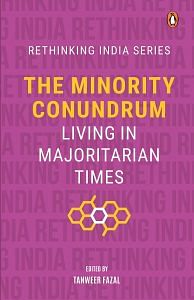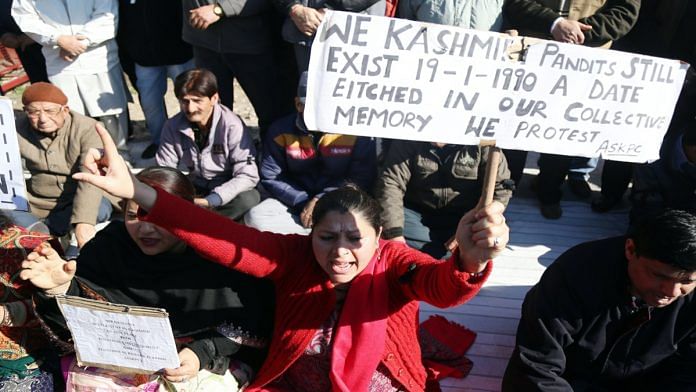The Pandits who came to cities such as Jammu found themselves seeking sanctuary in a place unlike their home. The condition of displacement is marked by uncertainty, and the Pandit story is no exception to this. Many had thought that their dislocation was temporary and that they would return to Kashmir once law and order was re-established, though dislocation has become a permanent feature of their lives. Out of 1,40,000 displaced Pandits, approximately 36,000 families were settled in displaced persons camps between 1990–2011 until the replacement of the camps by the township of Jagti.
The experience of camp life has been extensively documented by writers including Pandit writers such as Rahul Pandita and Siddhartha Gigoo, who emphasize the sense of alienation they felt in exile, shaped by nostalgia and longing for their home and homeland in Kashmir. In another work I have documented conversations with those who resided in the camps whose testimonies of the early days of displacement attests to a sense of alienation.
One man at a camp had this to say: ‘Then in 1994, the sarkar [the government] built “pigeon holes” [one-room tenements or ORTs], a kabutarkhana in which you cannot even keep buffaloes. The government set up tents in a place where men would be afraid to go alone. When they erected tents here, we saw nothing but snakes and scorpions. We would have to do this every night [he swung his hands and slapped the desk he sat behind to demonstrate]. Snakes would come out of the ground in their thousands. The comfort of the night would be ruined. It was a jungle, all the way to where we are sitting now. When we would go out to urinate, we would take a large stick and lantern . . . This would be around the time of 1990, ’91, ’94 and ’96. The locals would say that a churel [witch] lived here. The locals would come here to graze their buffaloes but after sunset, no one would dare to come since the churel will be prowling.’
Also Read: Eyes moist, heavy voice: Atal Bihari Vajpayee was helpless after meeting 10 Kashmiri Pandits
While Pandit–Muslim relations were marked by complexity in the past, the sense of divide that we imagine within this relationship needs to be interrogated. While Pandits may have felt pride over figures such as Nehru and may not connect to the movement for azaadi in Kashmir, their relationship to politics otherwise is not very clear. Were Pandits ardent Indian nationalists?
While organizations from the community such as Panun Kashmir or Roots in Kashmir or old diasporic associations openly support the Indian state and oppose Kashmiri nationalism as ‘patriotic Indians’, it is difficult to understand how Pandits related to politics in the past. In any case, if the Pandits were not Indian then, the displacement and conflict has made them Indians now. Many political parties often pay lip service to the Pandits, commenting on their suffering. In the Indian public sphere they become a useful case to blunt any criticism of the state if any report of human rights violations in Kashmir are presented. For Hindu nationalism, the Pandits critically provide a group of victims who are upper caste pitted against a movement that all shades of Indian politics, from liberal-secular to Hindu nationalist right wing, see as an Islamist movement.
In the process, the Pandits as a constituent of the Indian nation state have a curious relationship with Indian politics. Many Pandit organizations employ Indian nationalist and Hindu nationalist rhetoric that locate them within India and make them opposed to azaadi. Hence, in my experience, human rights organizations in India which understandably are sympathetic to people in the Valley, often appear to see the Pandits as becoming a constituent of Hindu nationalist and right-wing groups, which is a limited view.
The rage of the Pandits at their own conditions at times is directed towards the Muslims of Kashmir and anybody sympathetic to them, which further contributes to their image as an angry people. However, while Hindu nationalists may speak for the Pandits, with the current Indian government claiming it will carry out a series of measures for their benefit, little action appears to be done beyond rhetoric. In my experience, parties such as the BJP and Shiv Sena at the local level represent Hindu Dogra interests. Consequently, the Pandits are often derided by the locals in Jammu for having come to the city, for taking over large parts of the city and for not having ‘fought’ the Muslims in Kashmir and instead fleeing from Kashmir.
Conversations with Pandits often reveal that they were met with both some hospitality and hostility from the locals when they arrived in cities such as Jammu. A group of youth I had met recalled hearing songs such as: ‘Haath mein kangri / kandhe pe jhola / kaha se aye yeh Kashmiri Lola?’ (A brazier in hand/a cloth bag slung on the shoulder/from where have these Kashmiri refugees come?)
Also Read: Shikara an attempt to speak of unimaginable pain without spreading hate: Vidhu Vinod Chopra
All displaced people in Jammu and Kashmir are categorized as ‘migrants’ by the state and hence are eligible for relief, which comprises financial and food aid. To speak of migrants in Jammu is to speak of the Pandits. The Pandits are not the only displaced people, and many other groups, such as populations fleeing communal conflict in the Pahari areas or border migrants, comprising those who have fled villages around the border due to military action between Indian and Pakistani forces, are also eligible for state assistance. Yet, for some time, it appeared that the Pandits were the most visible group and received a higher corpus of support. Consequently, in areas such as Jammu, the Pandits were seen as a privileged group of victims living off the largesse of the state, unlike others. This connects to the older stereotype of Pandits as elites, which makes any discussion of Pandit suffering difficult.
While the displaced often have a difficult relationship in adjusting with locals, the Pandits appear to have an excessive relationship with the Indian nation state with unexpected consequences. While they may have been a religious minority in Kashmir and are part of a religious majority in exile in Jammu or New Delhi, it does not mean that they enjoy entirely cordial relations with other Hindus. As Hindus in a Hindu-majority area, they remain a minority.
Much of the attention of observers of all political shades is in relation to a territory. It is the Kashmir Valley that is converted into a zone of conflict. The people who are living in that zone are treated either as people resisting oppression and suffering state violence or as threats to the Indian state who deserve to be treated with violence. Whether we are looking at Kashmir from the standpoint of political parties of all shades of the political spectrum, the Indian state, Kashmiri nationalist organizations, journalists, social scientists, activists and the larger public, the concern is with the Valley.
Anybody outside the Valley, such as the Pandits, is outside our optics and hence somewhat irrelevant and reduced to rhetoric, regardless of our political preferences. However, given the ambiguity of their history and their location in relation to the Kashmir conflict, the Pandits offer a way to understand what being a minority means when it is refracted through histories of socio-economic and political inequality and questions of power. The challenge remains to think about the lives of groups such as the Pandits in relation to concerns of power and history and to yet consider potential futures that acknowledge justice, fairness and voice.

This excerpt from The Minority Conundrum: Living in Majoritarian Times edited by Tanweer Fazal has been published with permission from Penguin Random House India.







Many of the commanders here have no clear view of histirical facts of Kashmir. Still they comments for a monotonous reason. It has become order of the day for getting down on Islam for everything. There is definitely no second thought against injustice met out to Kashmir minorities. But the fact is wraped up against Islam by pro hindus, will not be ingenious perception, Instead it looks like using KP’s scenario to fuel Islamiaphobia among unbiased Hindu fraternity.
This is what happens when you pander to a community who insist that they can achieve HEAVEN AFTER killing a non believer. Pakistan is also an example what will happen when HINDUS become minority. Every other analysis is just hiding facts
Before exodus and strangely even now most Kashmiri pandits (KP) were pro National Conference and Abdullah family. They were also not vehemently against calls for peblisite or double talk by NC even when history had shown it would result in their extinction. Even today not more than 30 to 40 of KP percent are hindutva oriented or even hardcore BJP supporters. Now compare with almost unanimous continuing hatred among muslim based on Gujrat riot.
Kashmiri Pandits are dear to Hindus, no matter what. You can say privileged, elite, etc. But remember the KP were slaughtered by muslims, for example in Wandhama. The muslim murderers did not even spare infants and children. Entire families of KP were brutally murdered by muslims. Other “migrants”, like those who are displaced due to firing on the LOC, don’t have the traumatic history of oppression due to islam.
Kashmiri pandits remind hindus of the oppression of islam that this country has suffered for 1000 years.
It is a well settled fact that the muslims of kashmir have betrayed this country and islam must be exterminated from kashmir.
When that is done, then the Pandits shall return.
Of course, there are some asslickers of islam among the KP also. But they will also be severely dealt with. The KP are at least a symbol of our oppression due to islam.